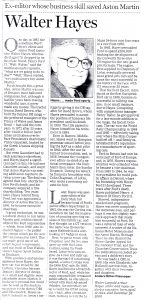Obituary
The Guardian
January 9th 2001
Anders Ditlev Clausager
courtesy and copyright of The Guardian
http://theguardian.com
Walter Hayes
Ex-editor whose business skill saved Aston Martin
One day in 1987, the sometime Fleet Street editor and senior Ford executive Walter Hayes, who has died aged 76, dropped in on his close friend, Henry Ford II. “Well, Walter,” said the multinational’s supremo, “what are we going to do today?” “Well,” Hayes replied, “we could always buy Aston Martin.”
Ford thought this a great idea. Aston Martin was one of Britain’s most hallowed companies, but, although it had for years been making wonderful cars, it never made any money. The tractor tycoon David Brown, who built the famous DB range – the preferred transport of the Prince of Wales and James Bond – had sold the company in 1972 after 25 years, after which it fell on hard times until taken over by Pace Petroleum’s charismatic Victor Gauntlett, backed by the Greek Livanos shipping dynasty.
But even Gauntlett had to seek assistance elsewhere, and Hayes played a significant part in this. He had met Gauntlett socially, and learnt that Aston Martin was seeking additional capital to develop a new car. The deal was agreed that July, shortly before Ford’s death, and his company acquired a 75% shareholding. Two years later, Hayes retired from Ford, but was appointed a director of Aston Martin; in 1991, he became executive chairman.
A great enthusiast, he was a natural choice to run Aston Martin and, with his knowledge of the Ford organisation – which, from 1989, also included Jaguar – he pulled the strings which got the new DB7 introduced in 1993. This car made good use of selected Jaguar components, and was built at Tom Walkinshaw’s Jaguar Sport factory at Bloxham.
With guidance and encouragement from Hayes, the new car was styled by Ian Callum, who later became Jaguar’s director of design. As a small and slightly more affordable Aston Martin, it broke new ground, but could also be seen as the modern successor to the classic DB2 and DB4 models. Hayes astutely linked it to Aston’s heritage by giving it the DB tag, after Sir David Brown, whom Hayes persuaded to accept the position of honorary life president until his death in 1993. The title passed to Hayes himself on his retirement in 1994.
Born in Harrow, Middlesex, Hayes went to Hampton grammar school before joining the RAF as a cadet pilot in 1943. After the war he turned to journalism, and, in 1956, became the youngest-ever editor-in-chief of a national newspaper, the Daily Mail’s then sister, the Sunday Dispatch. During his tenure, he formed a friendship with Colin Chapman, of Lotus, who wrote a motoring column for him.
Later, Hayes was associate editor of the Daily Mail, but became head of Ford’s public affairs department in 1962, the year the Cortina was launched. He had the inspiration of creating sporting versions of this family car, and first thought up a GT version; the name was chosen because Halfords had a nice-looking GT badge in stock.
Next, he got in touch with Chapman, and the two men came up with the Lotus Cortina, using the Ford-based, Lotus twin-cam engine. As a race and rally car, it was the start of a motoring legend; a Lotus Cortina won the 1966 RAC rally. By 1965, Hayes had become a board director of Ford, and, while his main responsibility remained public affairs, he was also involved with Ford Advanced Vehicles, the subsidiary set up to build the GT40 racing car, which, after a hesitant start, went on to win the Le Mans 24-hour race four years in a row from 1966.
In 1965, Hayes persuaded Ford to spend £100,000 backing the development of the Cosworth three-litre V8 engine for the new grand prix formula. The engine, first supplied to Chapman of Lotus, eventually powered most grand prix cars and became the most successful in the history of the race, with 175 wins over 30 years.
That the Ford Escort, introduced as the first European Ford car in 1968, became so successful in rallying was also, in no small measure, due to Hayes. Conspiring with competitions manager Henry Taylor, he got approval for a last-minute addition to the range, the Escort twin-cam. The car won the World Rally Championship in 1968 and 1969 – effectively taking over where the Mini Cooper had left off – and firmly established Ford’s reputation as a manufacturer of sporting cars.
Ford in Britain had now become part of Ford of Europe, and, in 1976, Hayes’s responsibilities were extended when he became a vice-chairman. From 1980 to 1984, he was vice-president for world public affairs in Detroit, where his friendship with Henry Ford II developed. Three years after Ford’s death, Hayes published Henry: A Memoir Of Henry Ford II.
Shrewd, independent-minded and pragmatic, Hayes was never completely the corporate man, and perhaps it was this slightly maverick approach that made him successful at Ford. He was a cultured man of wide interests. A trustee of the National Motor Museum and the Aston Martin Heritage Trust, he also chaired the Stowe Garden Appeal for the National Trust, and the Churches Conservation Trust. His publications included poems and a children’s story.
He was made a CBE in 1980. His wife Elizabeth (née Holland) survives him, together with their two sons and daughter.
Anders Ditlev Clausager
Walter Leopold Arthur Hayes, editor and motor industry executive, born April 12 1924; died December 26 2000
